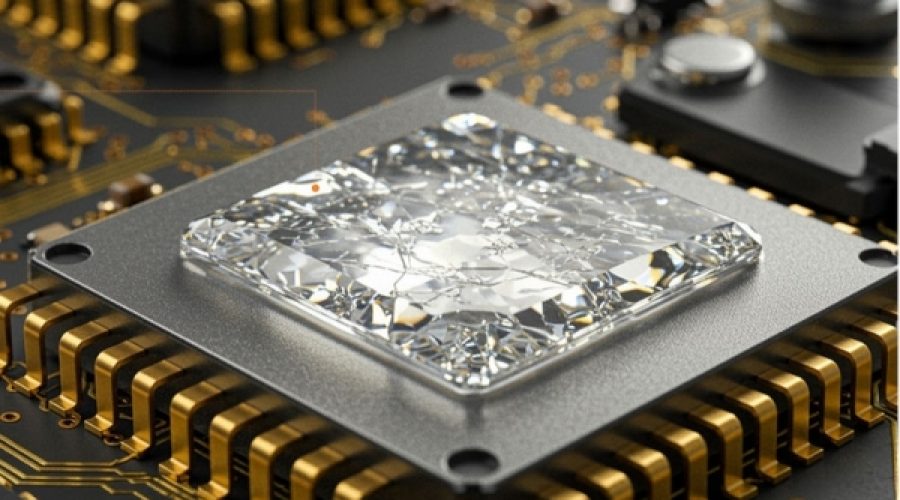الماسها انقلابی در تولید تراشه ایجاد میکنند: این موضوع برای سرمایهگذاران و کسبوکارهای فناوری چه معنایی دارد؟
با توجه به رقابت شرکتهای فناوری برای ساخت مراکز دادهای که سرورهایی با جدیدترین مدلهای هوش مصنوعی را در خود جای میدهند، مصرف برق این تأسیسات به شدت در حال افزایش است. با این حال، بخش عمدهای از این برق صرف انجام وظایف محاسباتی نمیشود، بلکه به صورت گرمای ناشی از میلیاردها ترانزیستور روی تراشههای مدرن هدر میرود.
آر. مارتین روشایزن، مهندس برق و کارآفرین در دایموند فاندری در جنوب سانفرانسیسکو، فاش کرد: «راز کثیف در تراشهها این است که بیش از نیمی از کل انرژی به صورت جریان نشتی در سطح ترانزیستور هدر میرود.» این گرمای هدر رفته نه تنها نشاندهنده اتلاف قابل توجه انرژی است، بلکه طول عمر تراشه را کاهش میدهد و راندمان را پایین میآورد و حتی گرمای بیشتری تولید میکند. در نتیجه، حفظ دمای سرورها در مراکز داده برای عملکرد بهینه بسیار مهم است.
برای مقابله با این مشکل، مهندسان، از جمله روشایزن، با جاسازی قطعات کوچک الماس مصنوعی در تراشهها برای افزایش خنککنندگی، نوآوریهایی را ارائه میدهند. الماسها نه تنها سختترین ماده شناخته شده هستند، بلکه در رسانایی گرما نیز عالی عمل میکنند. پل می، شیمیدان فیزیک در دانشگاه بریستول، اظهار داشت: «اکثر مردم نمیدانند که الماس بهترین خواص رسانایی گرما را در بین هر مادهای دارد.» او افزود که رسانایی گرمای الماس به طور قابل توجهی از مس، یک ماده رایج برای سینک گرما، پیشی میگیرد.
رسانایی حرارتی استثنایی الماس از ساختار اتمی آن ناشی میشود: هر اتم کربن به شدت با چهار اتم همسایه پیوند برقرار میکند و یک شبکه محکم ایجاد میکند که ارتعاشات گرما را به طور موثر از طریق کریستال منتقل میکند. همانطور که می اشاره کرد، «دستگاههای الکترونیکی پیشرفته در حال حاضر از پخشکنندههای گرمای الماس استفاده میکنند و به زودی پردازندههای دستگاههای روزمره مانند رایانههای شخصی و تلفنهای هوشمند احتمالاً از آنها بهره خواهند برد.»
اخیراً، شرکت روشایزن بر تولید لایههای الماس تک کریستالی برای ویفرهای سیلیکونی تمرکز کرده است که بهتر از آرایههای چند کریستالی خنک میشوند اما تولید آنها چالشبرانگیزتر و پرهزینهتر است. در همین حال، شرکت المنت سیکس، متعلق به شرکت دی بیرز، مدتهاست که الماس را برای مصارف صنعتی، از جمله تراشههای خنککننده در دستگاههای ارتباط رادیویی و ماهوارهها، تأمین میکند. اکنون، این شرکت بازار تراشههای کامپیوتری را هدف قرار داده است.
بروس بولیگر، رئیس توسعه کسب و کار در Element Six، تأکید کرد که نیازهای حرارتی هوش مصنوعی نسل بعدی و محاسبات با کارایی بالا، علاقه جدیدی را به فناوریهای پیشرفته خنککننده ایجاد میکند. در ژانویه، این شرکت یک ماده ترکیبی الماس-مس را معرفی کرد که برای عملکرد بهتر از مس به تنهایی در هدایت گرما و در عین حال مقرون به صرفهتر از الماس خالص طراحی شده است. بولیگر اظهار داشت که این کامپوزیت یک "راهکار مدیریت حرارتی بهینه" ارائه میدهد که میتواند تراشهها را قادر سازد سریعتر کار کنند، دوام بیشتری داشته باشند و هزینههای خنکسازی مراکز داده را کاهش دهند.
در دانشگاه استنفورد، سرابانتی چادوری، مهندس برق، در حال بررسی الماس برای توسعه تراشههای کامپیوتری قدرتمندتر است. روشهای سنتی افزایش سرعت تراشه با کوچک کردن ترانزیستورها و قرار دادن تعداد بیشتری روی ویفرهای سیلیکونی با محدودیتهای فیزیکی مواجه هستند. روی هم قرار دادن ترانزیستورها به صورت لایهای، چالشهای مربوط به گرما را بیشتر میکند.
تیم چادوری قصد دارد گرما را با استفاده از لایههای الماس چندبلوری هدایت کند، که تولید آنها آسانتر از تک بلورها است، اما با چالشهایی روبرو هستند زیرا جهتگیری عمودی معمول بلورهای آنها مانع جریان افقی گرما میشود - که برای تراشههای مسطح ضروری است. علاوه بر این، رشد الماس معمولاً به دمای بالای ۱۳۰۰ درجه فارنهایت نیاز دارد که به زیرلایههای سیلیکونی آسیب میرساند. تلاشها برای رسوب الماس در دماهای پایینتر با تشکیل بلور مواجه بوده است.
این کار که بخشی از بودجه آن توسط دارپا، بازوی تحقیقاتی وزارت دفاع ایالات متحده، تأمین شده است، نویدبخش آینده است. یوگندرا جوشی، مهندس مکانیک از دانشگاه جورجیا تک و دارپا، خاطرنشان کرد که ترکیب رشد الماس در دمای پایین با سایر روشهای خنککننده میتواند قابلیتهای محاسباتی را که در حال حاضر غیرقابل دسترس هستند، آزاد کند.
چودوری بر ضرورت رسیدگی به مدیریت گرما در بحبوحه گسترش سریع هوش مصنوعی تأکید کرد و این چالش را هم به عنوان یک چالش دیرینه و هم به عنوان یک چالش جدید توصیف کرد: «مشکل گرما از قبل وجود داشت، اما اکنون که رشد واقعاً با هوش مصنوعی همراه شده است، مانند یک چوب هاکی است - ما شاهد بزرگ شدن این مشکل هستیم. من چیزی ندیدهام که به این سرعت اینقدر مهم باشد.»
—نیویورک تایمز
تحلیل ویژه از عمانت | بازار عمان را کشف کنید
رشد سریع هوش مصنوعی و محاسبات با کارایی بالا، مصرف انرژی مراکز داده را به طرز چشمگیری افزایش میدهد و اتلاف گرما به یک گلوگاه حیاتی تبدیل میشود. برای کسبوکارهای فعال در بخشهای فناوری و داده عمان، سرمایهگذاری در فناوریهای پیشرفته خنککننده مانند پخشکنندههای گرمای مبتنی بر الماس، فرصت قابلتوجهی برای افزایش بهرهوری و کاهش هزینههای عملیاتی ارائه میدهد. سرمایهگذاران و کارآفرینان هوشمند باید حمایت از نوآوریهایی را که به چالشهای مدیریت حرارتی میپردازند، در نظر بگیرند، زیرا این راهحلها در حفظ موج بعدی رشد مبتنی بر هوش مصنوعی حیاتی خواهند بود و میتوانند عمان را به عنوان یک بازیگر رقابتی در بازار نوظهور زیرساختهای فناوری جهانی قرار دهند.



